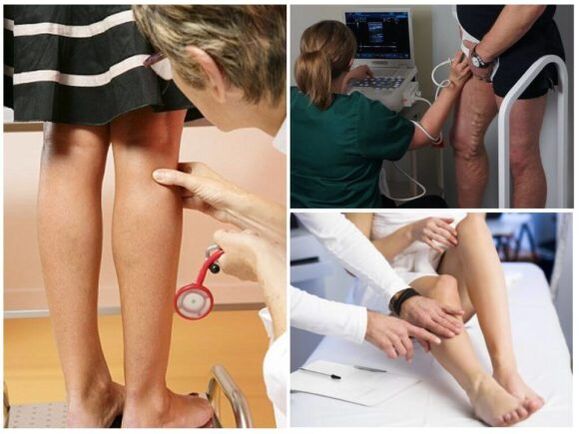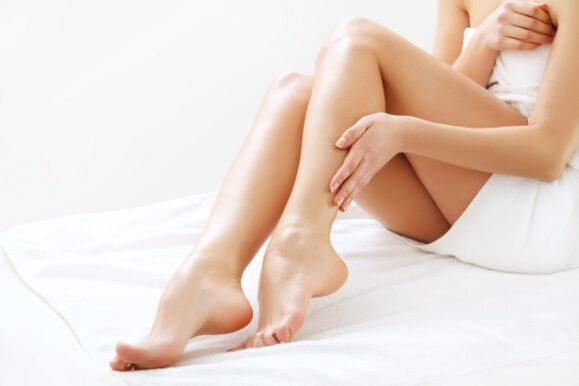Since you read the article, you are faced with a problem like varicose veins.The internal varicose veins are a common and familiar disease for men and women.The article below discuss the manifestations of the disease, diagnostic methods and information on how to treat internal varicose veins on the legs.

Symptoms
In a healthy state, the veins on the legs are not practically visible, they are hidden under the skin and work normally, without freeing any problems for a person.But with a disease such as internal varicose veins on the legs, it is possible to observe an extended venous mesh with nodes and in advanced cases with trophic ulcers.
Varicosis is not only a cosmetic defect, but also a very dangerous disease that should be detected in the early stages and consult a phlebologist.The varicosis of the veins in the limbs occurs due to the stagnation of the blood with a violation of the function of the venous valves, which helps blood to rise to the heart and do not go down.
Symptoms of deep veins, which should pay attention to:
- pigmentation, dryness, burning at the lower ends;
- swelling and gravity for or at the end of the day;
- pain at the lower ends;
- The appearance of an extended venous grid on the legs.

At the beginning of the disease, it is easy to win, but advanced cases are full of complications.
The internal varicose veins on the legs can cause the appearance of trophic ulcers that bleed and heal for a long time and the most dangerous consequence of the pathology is the formation of blood clots.
A thrombus at any time can detach and clog important ships, which can lead to death.Therefore, it is not necessary to ignore such an insignificant disease at first sight.
Varicose veins on the legs have a genetic predisposition.If the closest relatives have such a condition, be careful and perform preventive measures.
Reasons
The reasons for the appearance of a vascular network can be:
- excessive load on the legs;
- obesity;
- hormonal therapy;
- Pregnancy or menopause;
- uncomfortable shoes;
- A long living room on the legs (standing or sitting at work and lifestyle).
The internal expansion of the veins of the lower ends is clearly depicted in the photo.
Stages of course
The phases of the development of the disease are as follows:
- 1st stage: a person practically does not pay attention to his condition, sometimes hesitates after a long walk or serious physical effort.
- Second phase: by now the patient has already begun to swell, pain intensifies, a network of varicose appears, nocturnal cramps are possible.
- 3rd stadium: the aggravation condition, the swelling of the legs has improved, pigmentation appears, the veins expand even more and they obscure and you can see their node.
- 4th stadium: there is an increase in body temperature and the integrity of the skin is disturbed ulcers.This is the most difficult and dangerous phase.But very often it is in this state that people turn to the doctor, ignoring their previous states.
How is the diagnosis of varicose veins?
Initially, an examination of the doctor is carried out in which the color and conditions of the skin is assessed, the presence of swelling and display of venous expansion on the legs is verified.
Next is one of the following studies:

- The Gold Standard of Diagnostics is the Duplex Sinography method.A modern ultrasound method, which provides detailed information on the state of deep and surface ships.It only takes 20 minutes of time.A special preparation of the patient is not required.The diagnosis is performed in the ultrasound puppy.
- Dopplerography.The method allows to evaluate the nature of the blood flow, the state of the valves of the perforating and deep veins, their cross -country capacity, the presence of blood clots.
- Flebography refers to X -ray diagnosis methods. A good way to confirm the diagnosis, but requires the introduction of a question of contrast in Vienna, after which an X ray is taken.
By the way, the doctor evaluates the progress and basic cost of the light and also determines the presence of blood clots.
The purchase samples (bandage) had previously been used, but with modern technical skills that rarely use them.
What methods of treatment and prevention are effective?
Varicosis of the deep veins of the lower ends can and should be treated in a timely way!Don't be afraid and do not hesitate to contact a phlebologist with such a problem.In the early stages of the disease, you can get rid of it in a simple and painless way.
Initially, it is worth excluding those factors that can cause the disease:
- physical activity;
- improper shoes;
- Excess weight;
- Bad hormonal background.
But not all reasons can be regulated, for example, pregnancy or inheritance.In such cases, prevention must be remembered.
A good preventive method will be a moderate physical effort (running cowardly, walking with lifts, swimming, cycling).But at the same time do not forget to wear compression linen.
You must avoid overheating of the body, then exclude bathrooms, saunas and tanning.
Such small mistakes during working hours such as launching the legs on the leg, prolonged standing on the legs or the sitting position will adversely affect the health of the veins, then follow your business.
Exit the workplace every half hour and punches, in the case of a long standing position, change the support leg.Arriving at home, lie on the bed and raises the legs - so that the limbs rest, the swelling will decrease.
Special exercises
Patients with varicose veins can perform academic exercises for cleaning blood vessels.
The patient should stand on the socks, lift the heels 1 cm from the floor and then land drastically on the heels.You can repeat exercise 30-50 (no more than 60!) Times 3-5 approaches per day.The rhythm is slow, but with an acute landing.With a strong shock, the muscles of the heel pour and push the blood to the heart.
The internal varicose veins on the legs are treated with medical and surgical methods.

Drug therapy
The treatment with medicines will allow to overcome the disease in the early stages and prevent complications.
The drugs are prescribed for:
- increase venous tone;
- improve the lymphatic drainage function (reduce stagnant phenomena);
- improve tissue nutrition;
- Stop secondary inflammatory reactions.
Any medicines must be taken only as prescribed by a specialist!Do not medicate, so as not to aggravate the state of your health.
Surgical treatment
The surgical method is used in advanced conditions.It consists in the removal of expanded subcutaneous veins and insolvent perfume.This is a more radical treatment method.There are still methods such as stripping and binding.They also refer to the surgical, but are carried out on an outpatient basis.
Stripping is the removal of an expanded vein using a small probe.At the beginning and end of the ship, two small cuts are performed, a tool is started and fixed at the exit, then the probe together with Vienna is eliminated.
Advantages of this method: small cosmetic defects, a rapid recovery period, minor pain after intervention.
Ligating - Bandaging Varicose Veins, is practiced more as an additional method for stripping or radical removal.

MINIFLEBECCTOMY is an operational intervention with a minimum access: a special hook is introduced through the engraving, pulls the vein outwards, where it is blindfolded and cut.
To which method of treatment to resort to your case - only one specialist decides.
What does traditional medicine offer?
In folk medicine, carrot juices, spinach leaves, beets, celery and parsley just crushed have proved well.
You have to drink 500 ml per day.And particular attention is paid to the drinking regime, since the blood plasma is made up of water and other trace elements.With a lack of liquid, the blood is being inspected.The standard of water for humans: 40 ml for 1 kg of weight.
The internal expansion of the veins of the lower limbs is a serious but well -kept disease.Listen to your body, minimally violations, look at a doctor!













































